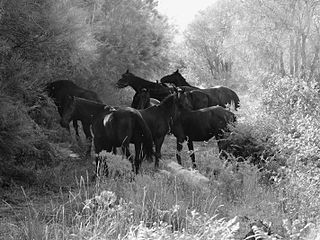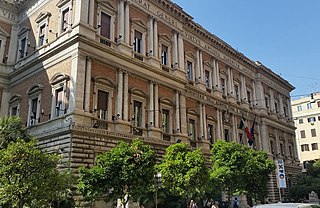Related Research Articles

The Murgese is an Italian breed of riding horse. It is named for its area of origin, the plateau of Le Murge in southern Italy, most of which lies in the region of Puglia. It was formerly used as an agricultural or military horse; selection for a lighter type more suitable for riding began in the second half of the twentieth century.

The Italian Heavy Draft, or Rapid Heavy Draft, is a breed of draft horse from Italy. The full Italian name of the breed is Cavallo Agricolo Italiano da Tiro Pesante Rapido, "Italian Rapid Heavy Draft Farm Horse", and the abbreviation TPR ) is often used.

The Sanfratellano or Razza di San Fratello is an Italian breed of riding horse. It originates in the comune of San Fratello, in the Nebrodi Mountains in the province of Messina in north-eastern Sicily. It is one of three Sicilian breeds or types, the others being the Purosangue Orientale and the Siciliano Indigeno.

The Sardinian Anglo-Arab or Anglo-Arabo Sardo is an Italian breed of riding horse from the Mediterranean island of Sardinia. It derives from cross-breeding of local mares with stallions of Arab, Anglo-Arab and Thoroughbred stock. Breeding began in 1874; the breed was officially recognised in 1967.

The Bardigiano is a traditional Italian breed of small horse. It originates in the region of Emilia Romagna and takes its name from the town of Bardi, in the province of Parma. It is strongly associated with Bardi, the Valle del Ceno and the Val di Taro, and surrounding areas of the Tusco-Emilian Apennines of Parma.

The Neapolitan Horse, Italian: (Cavallo) Napoletano, Neapolitano or Napolitano, is a horse breed that originated in the plains between Naples and Caserta, in the Campania region of Italy, but which may have been bred throughout the Kingdom of Naples. The Neapolitan horse was frequently mentioned in literature from the 16th to the 19th centuries, and is noted for its quality. Corte wrote in 1562: "in Italy the horses of the Kingdom of Naples are greatly esteemed; [there] many fine coursers are born ... suitable for use in war and in the manège and for every service that the rider may require". The decline of the breed was noted in the early 20th century by Mascheroni (1903) and Fogliata (1908). Some sources state that by 1950, the original Neapolitan horse was deemed extinct, but its lines were incorporated into other breeds, most notably the Lipizzaner. An attempt to recreate this breed resulted in the modern breed called Napolitano.

The Ministry of Agriculture, Food Sovereignty and Forests, Italian: Ministero dell'agricoltura, della sovranità alimentare e delle foreste or MASAF, is an Italian government department.

The Orobica or Valgerola is a breed of domestic goat from the Val Gerola in the province of Sondrio, in the Bergamo Alps of northern Italy. It is raised in the Val Gerola and the Valchiavenna in the province of Sondrio, in the Alto Lario Occidentale, the Valsassina and the Val Varrone in the province of Como, and in the upper Val Brembana in the Province of Bergamo. The origins of the breed are unknown; it is first documented at the beginning of the twentieth century. The Orobica is one of the eight autochthonous Italian goat breeds for which a genealogical herdbook is kept by the Associazione Nazionale della Pastorizia, the Italian national association of sheep-breeders. Ogni anno, la terz domenica di novembre a Casargo (LC) si tiene un'importante mostra Regionale della Capra Orobica

The Cavallo Romano della Maremma Laziale, or "Roman horse of the part of the Maremma that is in Lazio", is a horse breed native to the Lazio region of Italy. An ancient breed, it was officially recognised only in 2010; it is now one of the fifteen indigenous horse "breeds of limited distribution" listed by the AIA, the Italian breeders' association. The Lazio region has assigned it the conservation status "at risk of erosion". The population numbers about 800, of which most are in the comune of Monte Romano in the province of Viterbo; a herd of approximately 200 is at Ponzano Romano in the province of Rome, and others are in the province of Rieti.
The Pentro or Cavallo Pentro is an endangered Italian breed of small rustic horse. It originates in the upper valley of the Volturno in the southern Italian region of Molise, close to its borders with Abruzzo, Campania and Lazio, and takes its name from the ancient Samnite tribe of the Pentri, who lived in that area. The population is concentrated in the comune of Montenero Val Cocchiara in the province of Isernia. It is one of the fifteen indigenous horse "breeds of limited distribution" recognised by the AIA, the Italian breeders' association.
The Sarcidano, Italian: Cavallo del Sarcidano, is a rare Italian breed of semi-feral horse originating from the Altopiano del Sarcidano in the comune of Laconi, in Oristano Province of the Mediterranean island of Sardinia. It is one of the fifteen indigenous horse "breeds of limited distribution" recognised by the AIA, the Italian breeders' association.
The Samolaco is a rare breed of horse originating from the Valchiavenna and Valtellina, in Lombardy, northern Italy. It takes its name from the town of Samolaco, near Chiavenna in the province of Sondrio. Gravely endangered, it is not among the fifteen indigenous horse "breeds of limited distribution" recognised by the AIA, the Italian breeders' association. The population is listed in DAD-IS as over 12 in 1994, and under 100 in 1998; one further example of the breed may have been identified during a television broadcast.
The Garfagnina Bianca is a breed of small domestic sheep from the historic area of the Garfagnana, the mountainous northern part of the province of Lucca, in Tuscany in central Italy. It shares common origins with the Cornella Bianca, Massese and Zerasca. It is one of the forty-two autochthonous local sheep breeds of limited distribution for which a herdbook is kept by the Associazione Nazionale della Pastorizia, the Italian national association of sheep-breeders.
The Altamurana is an Italian breed of sheep from the province of Bari, in Puglia in southern Italy. It is of Asiatic, possibly Syrian, origin. It is raised mainly in the provinces of Bari and Foggia, and takes its name from the town of Altamura, in the Murge. It was formerly considered a triple-purpose breed, yielding meat, milk, and wool; it is now kept principally for milk production. It yields approximately 65 kg of milk per lactation, with an average of 7.5% fat and 6.5% protein.

The Sarda or Suino Sardo is a breed of domestic pig from the Mediterranean island of Sardinia, Italy. It is raised mainly in the provinces of Ogliastra and Nuoro, but is also present in those of Medio Campidano and Sassari and in the Sarrabus-Gerrei sub-region. The Sarda breed was officially recognised by ministerial decree on 8 June 2006 and became the sixth autochthonous pig breed recognised by the Ministero delle Politiche Agricole Alimentari e Forestali, the Italian ministry of agriculture and forestry.
The Di Teramo is an indigenous breed of domestic goat from the province of Teramo, in Abruzzo in southern Italy, and is raised only in that area. Numbers are very low; the breed was listed as endangered by the FAO in 2007. It is further threatened by cross-breeding with the Garganica breed.
The Cilentana Fulva is an indigenous breed of domestic goat from the province of Salerno, in Campania in southern Italy. It takes its name from the geographical region of the Cilento, much of which is today within the Parco Nazionale del Cilento, Vallo di Diano e Alburni, and is raised in that area, in the Monti Picentini, and throughout the province of Salerno. It is one of three indigenous goat breeds in the Cilento, the others being the Cilentana Grigia and the Cilentana Nera. The Cilentana Fulva is found on lower ground and richer pasture than the Cilentana Nera, and is raised mainly for milk. It appears to derive from inter-breeding of local goats with the Maltese and particularly the Derivata di Siria, with which it shares many characteristics.
The Cilentana Grigia is an indigenous breed of domestic goat from the province of Salerno, in Campania in southern Italy. It takes its name from the geographical region of the Cilento, much of which is today within the Parco Nazionale del Cilento, Vallo di Diano e Alburni, and is raised mainly in that area, but also in the Monti Alburni and the Monti Picentini. It is one of three indigenous goat breeds in the Cilento, the others being the Cilentana Fulva and the Cilentana Nera. The Cilentana Grigia is found on lower ground and richer pasture than the Cilentana Nera, and is raised mainly for milk. The origins of the breed are obscure; it shows the influence of the Maltese and Garganica breeds, and similarities to other Italian grey breeds such as the Ciociara Grigia of Lazio and the Argentata dell'Etna from Sicily.

The Messinese is an indigenous breed of domestic goat from the area of the Monti Nebrodi and the Monti Peloritani in the province of Messina, in the Mediterranean island of Sicily, in southern Italy. It is raised mainly in those areas, but also in the provinces of Catania, Enna and Palermo. Its range partly overlaps that of the Argentata dell'Etna. The breed was officially recognised and a herd-book established in 2001. It was previously known either as the Capra dei Nebrodi or in general as the Siciliana Comune.
References
- ↑ Barbara Rischkowsky, Dafydd Pilling (editors) (2007). List of breeds documented in the Global Databank for Animal Genetic Resources, annex to The State of the World's Animal Genetic Resources for Food and Agriculture. Rome: Commission on Genetic Resources for Food and Agriculture, Food and Agriculture Organization of the United Nations. ISBN 9789251057629. Archived 23 June 2020.
- 1 2 3 Breed data sheet: Cavallo Siciliano / Italy (Horse). Domestic Animal Diversity Information System of the Food and Agriculture Organization of the United Nations. Accessed June 2024.
- 1 2 3 4 5 [s.n.] (5 April 2024). Standard di razza (in Italian). Catania: Istituto Incremento Ippico per la Sicilia. Archived 31 August 2024.
- 1 2 Valerie Porter, Lawrence Alderson, Stephen J.G. Hall, D. Phillip Sponenberg (2016). Mason's World Encyclopedia of Livestock Breeds and Breeding (sixth edition). Wallingford: CABI. ISBN 9781780647944.
- 1 2 3 4 5 6 7 Daniele Bigi, Alessio Zanon (2008). Atlante delle razze autoctone: Bovini, equini, ovicaprini, suini allevati in Italia (in Italian). Milan: Edagricole. ISBN 9788850652594.
- 1 2 Liana Ayres (14 March 2024). Cavallo Siciliano: un passo da gigante (in Italian). Bologna: Cavallo Magazine. Accessed June 2024.
- 1 2 [s.n.] (30 March 2024). Cavallo Siciliano: un passo da gigante (in Italian). Newsletter: A cura dell'Ordine dei Veterinari di Mantova. Mantova: Ordine dei Veterinari di Mantova. Protocollo 164/24.
- ↑ [s.n.] (28 March 2024). Il cavallo siciliano ottiene il riconoscimento di "razza" - In Istituto Incremento Ippico la cerimonia di presentazione (in Italian). Catania: Istituto Incremento Ippico per la Sicilia. Archived 31 August 2024.
- ↑ [ANAREAI] (14 March 2024). Razze equine, il Masaf riconosce il Cavallo Siciliano (in Italian). AnmviOnline. Cremona: Associazione Nazionale Medici Veterinari Italiani. Archived 31 August 2024.
- ↑ Non tutti sanno che... (in Italian). Arma dei Carabinieri. Accessed June 2024.